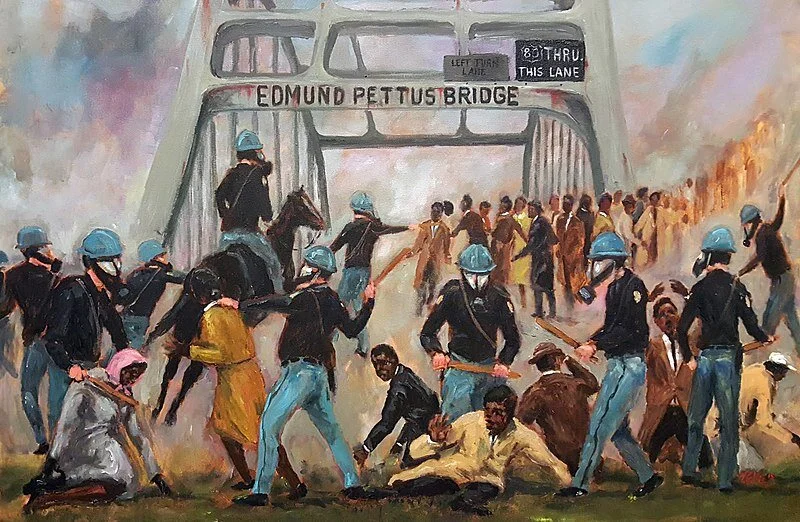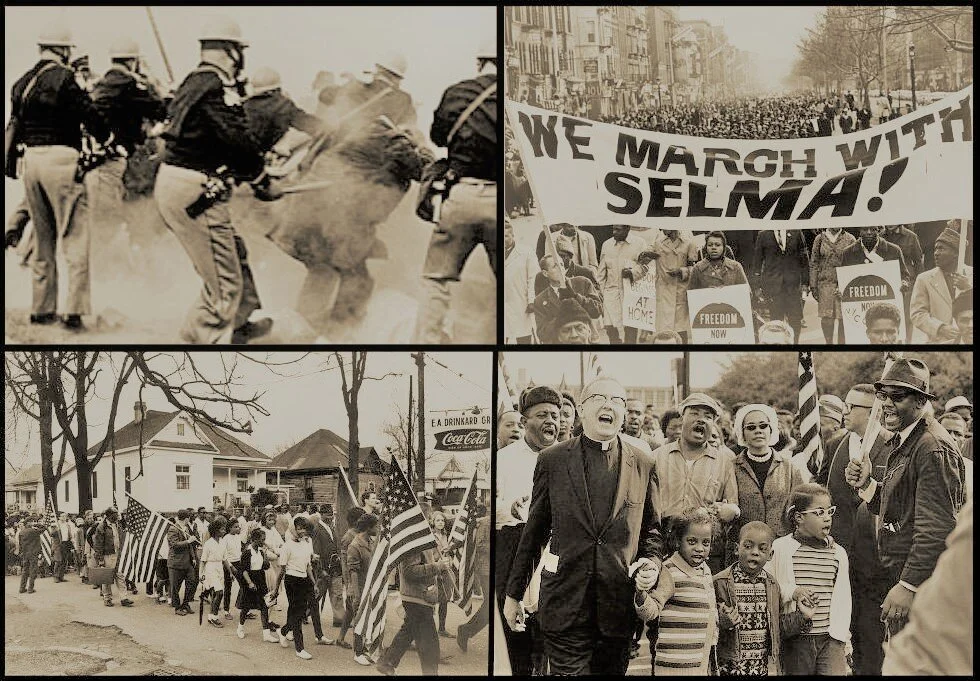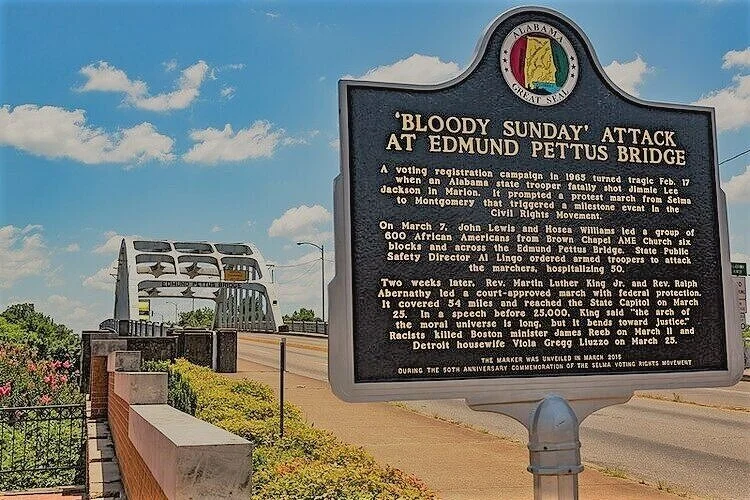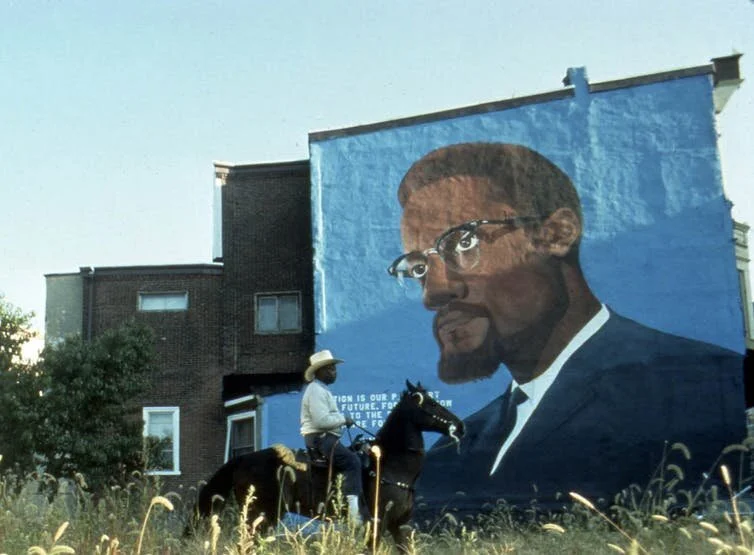Who Was Edmund Pettus? A Decorated Confederate General & KKK Grand Dragon
/By Errin Whack, SmithsonianMag.com. Originally written on March 7, 2015
As the country marks the 50th anniversary of “Bloody Sunday” – the fateful day in March, 1965, when a march for black voting rights from Selma to Montgomery was brutally interrupted by state troopers and the posse organized by the city’s sheriff -- many may recall the march’s starting point: the Edmund Pettus Bridge, which still stands today. But far less known is the story of the man for whom this landmark is named.
The bridge was dedicated in May 1940, more than three decades after Pettus’ death. Naming the bridge after Pettus was more than just memorializing a Civil War hero. Built over the Alabama River, a key route for the state’s plantation and cotton economy during slavery and Reconstruction, the bridge carries a particularly symbolic name.
Pettus was regarded as a hero in his native state and adopted hometown of Selma, a lawyer and statesman who served as a U.S. senator. But he was also a decorated Confederate general and a leader in the Alabama Ku Klux Klan.
At the time, Selma “would’ve been a place where place names were about [black people’s] degradation,” says Alabama historian Wayne Flynt. “It’s a sort of in-your-face reminder of who runs this place.”
In the program book commemorating the dedication, Pettus is recalled as “a great Alabamian.” Of the occasion, it was written, “And so today the name of Edmund Winston Pettus rises again with this great bridge to serve Selma, Dallas County Alabama and one of the nation’s great highways.”
So even as the bridge opened as a symbol of pride for a battered South still rebuilding decades after the Civil War, it was also a tangible link to the state’s long history of enslaving and terrorizing its black inhabitants.
“The bridge was named for him, in part, to memorialize his history, of restraining and imprisoning African-Americans in their quest for freedom after the Civil War,” says University of Alabama history professor John Giggie.
Born in Limestone County, near the Alabama-Tennessee border, on July 6, 1821, Pettus was the youngest of nine children. His father was a wealthy planter and his mother the offspring of a Revolutionary War veteran. After passing the state bar in 1842, Pettus moved further south to open a law practice in Gainesville, Alabama. Within two years, Pettus married and began serving as a local solicitor.
Growing up, Pettus’ family profited enormously from the economy of the Deep South, owning slaves and producing cotton. But it was Pettus’ belief in white supremacy, and not pure economics that drove his support for the Confederacy. Limestone County was, like other parts of northern Alabama not in favor of secession.
Pettus, however, was not a man of his region, said Flynt.
“His fanaticism is borne of a kind of pro-slavery belief that his civilization cannot be maintained without slavery,” says Flynt. “He lives in an area full of people who oppose secession. He is going against the grain. He’s not a reluctant pragmatist, brought to secession to go along with the people. He’s a true believer.”
“In the antebellum period, he was a living symbol of the laws and customs and beliefs about slavery.” says Giggie. Pettus was living not far from Selma when he was recruited by prominent secessionists to be a leader in their movement.
In the months before the start of the Civil War, Pettus was a part of an entourage who petitioned his older brother John, then the governor of Mississippi, to persuade the state to leave the Union and join the Confederacy.
Pettus rose quickly through the ranks: By 1863, he was promoted to brigadier general, placing him in charge of five Alabama regiments. Pettus was captured at Vicksburg -- where his “daring and courage” was described as “legendary” -- and served in battles at Lookout Mountain in Tennessee and Kennesaw Mountain in Georgia. A three-time prisoner of war (he escaped once and was in a prisoner exchange twice), he was seriously wounded days before the Confederacy surrendered.
Examples of his passionate leadership survive. Pettus said in a statement to his troops on April 28, 1865, three weeks after Robert E. Lee surrendered at Appomattox Court House:
You have now served your country faithfully for more than three years. On many hard fought fields your determination and valor has been proved … Now you are subject to a new trial. The fortunes of war have made you prisoners … Your valor and good conduct has my greatest joy and pride; and it is confidently expected that the reputation of this command will still be preserved in this new trial!
Though others may desert and disgrace themselves, & their kindred, let us stand together and obey orders! In this way we best contribute to our safety, and comfort; and preserve our caracters (sic) untarnished.
Let our motto be “Do our duty in trusting God.”
After the war, Pettus settled in Selma, the Queen City of the Black Belt -- one of the wealthiest regions in America at the time due to cotton production. He arrives in Selma a war hero, and like many other successful planters, he came first as a lawyer, using the money made from his practice to buy farm land.
During the era of Reconstruction, when blacks—now free and the majority of the population in Alabama and throughout most of the Black Belt – were terrorized by the emergent Ku Klux Klan, Intimidation through violence was extensive. In the latter part of the 19th century, Alabama led the nation in lynchings, and Dallas County -- where Selma is located -- was no exception.
And whether Pettus participated in the violence directly or not is unknown, but he certainly would not have opposed it, Flynt said.
“I would be very surprised if a man of his social standing actually went out with guns and masks on, but the fact that he knew what was happening is almost inevitable,” Flynt said. “There’s really no way of excluding Edmund Pettus of responsibility from the violence. He helps organize it, he helps protect it, and he does not seek to prosecute anyone who did it.”
“Pettus became for Alabama’s white citizens in the decades after the Civil War, a living testament to the power of whites to sculpt a society modeled after slave society,” says Giggie.
Pettus served as chairman of the state delegation to the Democratic National Convention for more than two decades, and was Grand Dragon of the Alabama Klan during the final year of Reconstruction.
“White planters had lost control of this society,” Flynt said. “The conservative Democratic Party was attempting to restore the old order, to disenfranchise blacks, to create a servile labor force. The conservative Democratic Party and the Ku Klux Klan were like a hand and glove.”
In 1896, at the age of 75, Pettus ran for U.S. Senate as a Democrat and won, beating incumbent James L. Pugh. His campaign relied on his successes in organizing and popularizing the Alabama Klan and his virulent opposition to the constitutional amendments following the Civil War that elevated former slaves to the status of free citizens.
Upon his election, Selma threw a reception for the newly minted senator. In reporting the occasion, one headline proclaimed that Pettus “Was Received with Booming Guns And The Shrill Whistles of all Our Industries” and the story went on to refer to the general as “Selma’s distinguished citizen.”
“That he was elected statewide demonstrates the power of a Confederate pedigree and the Ku Klux Klan political machine,” Flynt said. “You didn’t get the nomination unless you had the support of white elites in the Black Belt.”
He was re-elected in 1903 and served until he died in 1907, about halfway into his second term.
Pettus was revered in death; his Senate eulogy declared: “He had control of the varied emotions and ambitions of the soul, a philosophic view of the failures and disappointments that come to all, and existed in an atmosphere above the level of envies, jealousies, and hatreds of life itself. Such men are rare, and dear old Senator Pettus was a conspicuous type of that class.”
Fast forward 33 years, and a bridge bearing Pettus name opens in Selma, a striking example of Alabama’s racial strife. In the bridge dedication program, city leaders called the day “much more than the opening of another bridge.” Instead, they explained: “The occasion marks another epoch in the growth and advancement of Dallas County … The new bridge is the answer to ‘The March of Progress.’” Much like apes progressed on to Homo sapiens, the city saw the Pettus Bridge as a sign of its own emergence into a new, proud future.
It is with some irony, then that the bridge would become the symbol of the South’s backward and regressive view toward civil rights equality.
Almost by design, the Edmund Pettus Bridge provided one of the most indelible images of the terror of the Jim Crow South. Rev. Martin Luther King, Jr., was no stranger to Alabama -- having waged civil rights campaigns in Montgomery in 1955 and Birmingham in 1963 -- chose Selma as the stage for the fight over voting rights because it was representative of many cities of the Deep South, where African-Americans were a majority of the population, but a minority of registered voters. The city's sheriff, Jim Clark, provided King a foil not unlike Birmingham's Bull Connor; King's strategy was to bait Clark into a showdown that would generate national media attention and put a spotlight on the issue. The bridge was an unintentional, but iconic setpiece.
“What had once been up until the 1950s a bridge that connected the Southern present to the Southern past ... gets rearranged after that march,” Giggie says. “The blood shed by those marchers very much reconsecrated the meaning of that bridge. It becomes less a symbol of the South’s past and a symbol of hope for its future.”
Today, a movement is afoot to rename the bridge. As of Saturday, a Change.org petition addressed to the National Park Service, the mayor of Selma and governor of Alabama was 40,000 signatures short of its 200,000-signatories goal.
While the bridge certainly is not the only Southern landmark to pay tribute to the ugly stain of racism in this country, it is among the most prominent -- which makes its origins, and its evolution, particularly relevant, explains University of Connecticut history professor and New Yorker contributor Jelani Cobb.
“You would think that in the rhetoric around civil rights, people would’ve talked about what reclaiming that bridge meant,” says Cobb, whose family has Alabama roots, but who did not know the history of the bridge.
“If the bridge is being so heavily identified with the black freedom struggle, we should be able to appreciate how much of an act of reclamation this is. People need to know that.”
“We were in the process of changing the history of the South,” says Andrew Young, one of the leaders of the Civil Rights Movement who marched in Selma. It’s a thrilling rejoinder to the comments made upon the bridge’s dedication.
But when told, “A lot of people don’t even know who Edmund Pettus was,” Young responded, “I don’t either.”
Having Pettus’ biography listed out, Young responded perfectly: “Figures.”



































